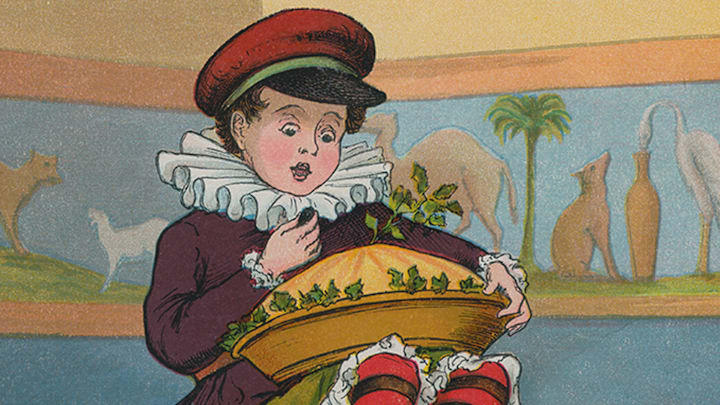“Little Jack Horner” is a particularly short nursery rhyme, with the whole jingle totaling just six lines:
“Little Jack Horner
Sat in the corner,
Eating his Christmas pie;
He put in his thumb,
And pulled out a plum,
And said, ‘What a good boy am I!’”
These easy as pie lyrics may seem sweet and simple, but like most nursery rhymes, rumors have long swirled about its allegedly dark origin story—one that’s said to involve Henry VIII and bribery. Let’s crack open the crust and dig into the history of this rhyme to uncover the truth about Jack and his Christmas pie.
A Plum Rhyme
The first printed reference to a Jack Horner character appears in 1665, with his name and associated corner—in this case a “chimney corner”—cropping up in a pamphlet attacking alchemist George Starkey. Although the rhyme existed orally before 1665, the earliest surviving written record of a full version of the verse (aside from the last line) is from 1725, in Henry Carey’s parody poem “Namby Pamby:”
“Now he sings of Jackey Horner
Sitting in the Chimney-Corner,
Eating of a Christmas-Pye,
Putting in his Thumb, Oh fie!
Putting in, Oh fie! his Thumb,
Pulling out, Oh strange! a Plumb.”
Carey’s poem was a satiric dig at Ambrose Philips, who wrote poetry for the children of aristocrats, so that (according to Carey) their “Father’s Gracy-Grace / Might give him a Placy-Place.” As for the melody, the earliest version of the tune that we sing today appears in J.W. Elliott’s National Nursery Rhymes (1870). The tune is mentioned early as 1731, appearing at the end of Henry Fielding’s satirical play The Welsh Opera, but which melody was actually played is unknown.

The earliest extant non-satirical version of the rhyme can be found in the 1750 chapbook The History of Jack Horner. In this story, Jack himself sings the rhyme, with the rest of the narrative being based on the 17th-century poem “The Fryer and the Boy,” which is itself based on the 15th-century poem “Jack and His Stepdame,” neither of which are related to the children’s rhyme.
The lyrics also appear in Mother Goose’s Melody; or Sonnets for the Cradle, which dates back to at least 1791, but may have been published as early as 1765. After the rhyme, Jack is described as “a boy of excellent taste,” and so it is “supposed that his father apprenticed him to a mince pye-maker.” In the UK, mince pies originally contained a mixture of meat and fruit (but nowadays, no meat is found in the filling).
Having A Finger in Every Pie
Many adult-oriented publications followed Carey’s lead by using “Little Jack Horner” to comment on opportunistic people. For instance, in a 1796 epigram, Reverend Samuel Bishop, criticized exploitative statesmen:
“What are they but JACK HORNERS, who snug in their corners,
Cut freely the public pie?
Till each with his thumb, has squeez’d out a round Plumb,
Then he cries, What a Great Man am I!”
Thomas Love Peacock used the rhyme to similar effect in his satirical novel Melincourt (1817). Horner is described as “one of the most splendid examples on record of the admirable practical doctrine of ‘taking care of number one.’” Five greedy characters then sing about taking advantage of the public; Horner’s pie is “Interpreted to mean the public purse,” and they gleefully declare that they’ll “all have a finger in the CHRISTMAS PIE.”
The 1820s saw the publication of The Renowned History of Little Jack Horner, an extended and revised version of the children’s rhyme which reverses Jack’s selfishness. Jack shares his pie with a hungry woman, prompting his mother to bake him a new pie as a reward for his generosity, and the poem then finishes with a moralization:
“Now let ev’ry good boy;
With a sweetmeat or toy,
Not slily sneak into a corner,
But to playmates repair,
And give them a share.
In short, imitate little Jack Horner.”
Eat Humble Pie
As for the rhyme’s inspiration, there’s a rumor that it was based on an incident in the life of Thomas Horner, a steward to Richard Whiting, Abbot of Glastonbury. Between 1536 and 1541, Henry VIII seized Catholic proprieties across England and the story goes that Whiting tried to bribe the King with estates and manors in an attempt to keep Glastonbury Abbey under his control. Horner was tasked with secretly transporting the title deeds to the King, but on his way he put his hand into the pie (which may just be a metaphor), and pulled out the deed to Mells Manor (the metaphorical plum) for himself.

The connection between Jack Horner and Thomas Horner had been suggested as early as 1862, but there a few issues with the tale. Some sources say that it was John Horner who was Whiting’s steward, but regardless of whether it was John or Thomas, John Leland actually reports in his Itinerary that the Horners legally bought Mells Manor from the crown in 1543—four years after Glastonbury was seized.
The Horner family certainly benefited from the Dissolution of the Monasteries, with their takeover of the Manor supposedly inspiring a rhyming couplet—“Horner, Popham, Wyndham and Thynne, / When the abbot came out, then they went in”—but that doesn’t mean that Horner had sticky fingers. Chris Roberts, author of Heavy Words Lightly Thrown: The Reason Behind the Rhyme (2003), suspects that the rhyme is “the Catholic take” on Horner gaining from Henry VIII’s redistribution of land. However, the editors of A Dictionary of English Folklore (2003), Jacqueline Simpson and Steve Roud, believe that “the story has little to connect it to the rhyme beyond the surname Horner.”
Whether Little Jack Horner started out as a greedy thief, a lucky landowner, or simply a pie-loving boy is unknown, but he continues to get a bad rap; for instance, he became the villainous Big Jack Horner in 2022’s animated film Puss in Boots: The Last Wish.
Read More Stories About Nursery Rhymes:
